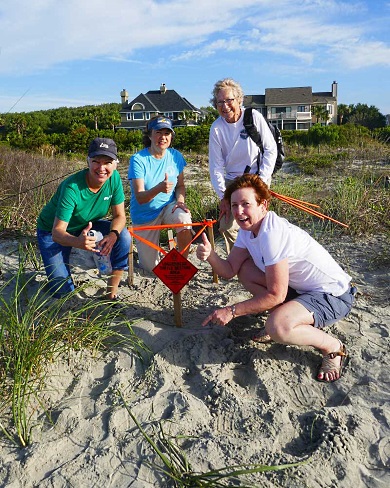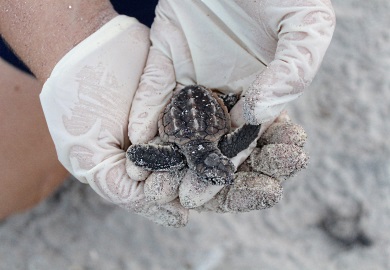DNR News** Archived Article - please check for current information. **
Isle of Palms beach sees first sea turtle nest of 2017May 1, 2017
Sea turtle nesting season has begun right on cue this year.
The South Carolina Department of Natural Resources (SCDNR) is excited to share that the state's first sea turtle nest of 2017 was laid on Isle of Palms over the weekend. Isle of Palms sea turtle volunteer Bill Schupp discovered tracks on the beach the morning of April 30, 2017, and a group of fellow volunteers returned to verify the location of the freshly dug nest.

Volunteers with the Isle of Palms/Sullivan's Island turtle team celebrate the state's first nest of the season. (Photo: Barb Bergwerf)
"We have never had an April nest before and were quite surprised when Bill Schupp called and said that there were tracks near the 56th Avenue access path," wrote longtime volunteer Barb Bergwerf. The nest turned out to be the first reported not just in South Carolina, but in Georgia and North Carolina, too.
South Carolina's official sea turtle nesting season runs from May 1 to October 31 each year. This year has already been busier than normal for staff and volunteers who respond sick, injured, or dead sea turtles that wash ashore. An unusually warm winter prompted the early arrival of sea turtles in South Carolina waters, many in pursuit of cannonball jellyfish and other favorite food items. Now, SCDNR biologists are expecting another year of high nesting, if not as high as last year.
Sea turtle nest numbers broke records across the Southeast in 2016, including South Carolina, where a total of 6,444 loggerhead nests were laid – the highest number counted since the founding of SCDNR's sea turtle program in the late 1970s. That's still a long way from the federal Loggerhead Recovery Plan's goal of 9,200 nests, but biologists across the region are optimistic that the recent gains represent the beginning of recovery for these threatened reptiles after several decades of conservation efforts.
"Many of our beaches experienced heavy erosion last fall during Hurricane Matthew, reducing the amount of ideal sea turtle nesting habitat," said Michelle Pate, SCDNR biologist and sea turtle program coordinator. "As a result of that we may see more nest relocations this season, as trained staff and volunteers move eggs to safer ground, but overall we're hopeful for another successful year of nesting."
Volunteers from 30 different nest protection programs will spend the next several months patrolling South Carolina's beaches each morning for crawls, the telltale tracks left by a female sea turtle as it trundles ashore. Between bright lights, hazardous debris, and natural or man-made obstacles, beaches can be treacherous places for nesting females. Incubating eggs face additional threats, including erosive high tides and predators such as coyotes and raccoons.
Sea turtle clutches average 120 eggs and hatch after approximately 60 days. Nesting females may remain in South Carolina waters and continue to nest every two weeks, laying up to six nests per season. Throughout this stressful time, the turtles also abstain from eating. Because nesting exacts a high energy toll on the large reptiles, female sea turtles do not come ashore to lay eggs every year. This cyclical nesting pattern results in fewer sea turtle nests in some years than in others. In 2014, for instance, sea turtles laid just 2,097 nests along the South Carolina coast, following 5,194 nests in 2013.

In 2016, nearly 400,000 loggerhead sea turtles hatched on South Carolina beaches. (Photo: E. Weeks/SCDNR)
Ongoing genetic analysis represents an exciting avenue of research in which SCDNR biologists continue to participate with a multi-state team led by Dr. Brian Shamblin of the University of Georgia. By collecting genetic samples from every nest identified in South Carolina, researchers can pinpoint the individual females that laid each nest – data that allows scientists to gauge the health of the overall nesting population and map family trees for the region's sea turtles.
Four sea turtle species nest on South Carolina beaches: loggerheads, greens, Kemp's ridleys, and leatherbacks. Loggerhead nests comprise the vast majority of the state's total number each year. All four sea turtle species are classified as endangered or threatened and are protected under the Endangered Species Act in addition to local and state ordinances. Individuals that violate federal law by harming or interfering with sea turtles or their nests can be subject to civil penalties of up to $25,000 and up to a year's imprisonment.
South Carolina beachgoers can help the state's sea turtles by keeping beaches free of holes, trash, and obstructions, turning beachfront lights out (or closing window blinds) to avoid disorienting turtles, and giving all sea turtles and nests a wide and respectful berth when encountered on the beach.
Sea Turtle Nesting Season Reminders
- Keep Lights Out! on beachfront property during nesting season.
- Refrain from using flash photography on the beach at night.
- Keep our beaches and ocean clean. Trash items such as plastic bags and balloons can cause injury or death when sea turtles mistake them for jellyfish, a favorite food.
- Respect sea turtles by observing them from a distance on the beach.
- Report dead or injured sea turtles and nest disturbances to SCDNR at 1-800-922-5431.
- Report sightings of live, healthy turtles to SCDNR.
- Promote and support our program for continued conservation of sea turtles in South Carolina.
| Area | Personnel | Number |
|---|---|---|
| Coastal, Midlands | David Lucas | 843-610-0096 |
| Marine | Erin Weeks | 843-953-9845 |
| Upstate, Midlands | Greg Lucas | 864-380-5201 |
After Hours Radio Room - 803-955-4000
